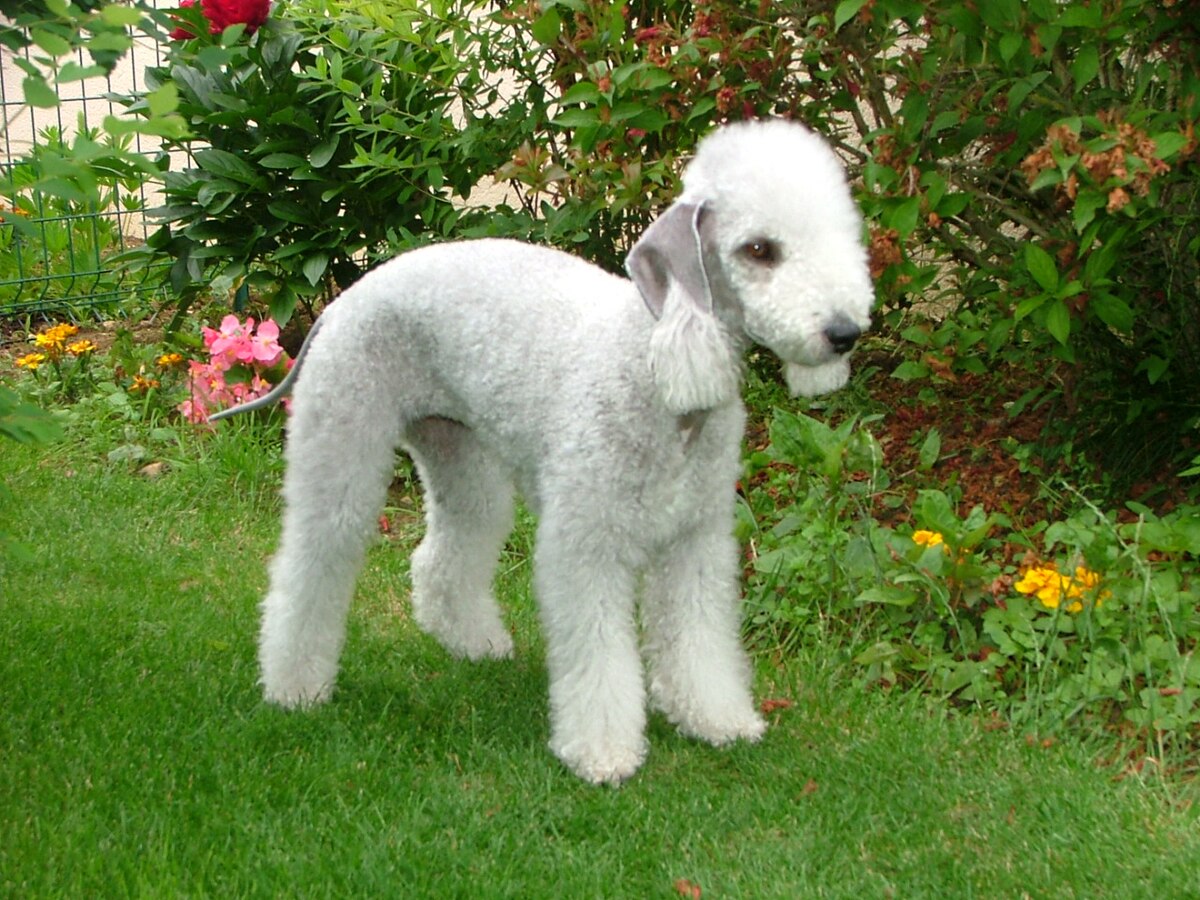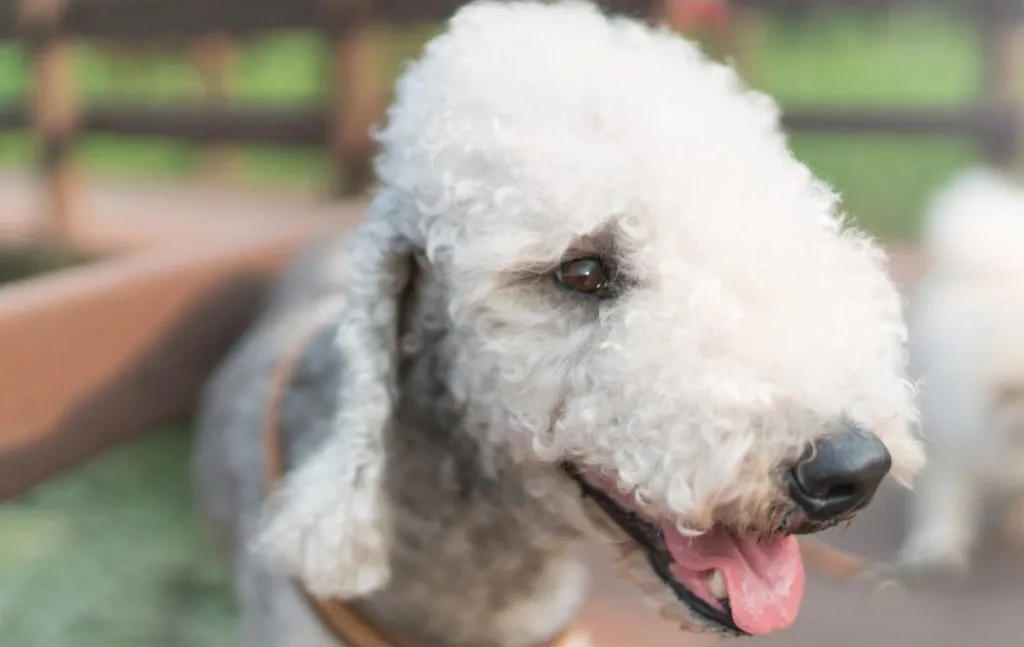Introduction
The Bedlington Terrier is a unique and charming dog breed known for its lamb-like appearance and lively personality. Originally bred for hunting and vermin control, this breed has since become a beloved family pet. In this comprehensive guide, we’ll explore the history, characteristics, care requirements, and common health issues of the Bedlington Terrier. Let’s dive into the fascinating world of this curly-coated canine!
History of the Bedlington Terrier
Origins
The Bedlington Terrier hails from the mining town of Bedlington in Northumberland, England. The breed was first known as the “Rothbury Terrier” due to its popularity in the Rothbury district. Miners and gypsies bred these dogs for hunting rats, badgers, and other small game. The breed’s keen sense of smell and tenacity made it a valuable asset in controlling vermin populations.
Evolution
In the early 19th century, the breed’s name was changed to Bedlington Terrier. Over time, the breed’s appearance and temperament were refined through selective breeding. The Bedlington Terrier we know today is a blend of various terrier breeds, including the Whippet, which contributed to its distinctive arched back and graceful gait.
Recognition
The Bedlington Terrier was officially recognized by the Kennel Club in England in 1877. It later gained recognition by the American Kennel Club (AKC) in 1886. Today, the breed enjoys popularity in dog shows and as a companion animal.
Physical Characteristics

Size and Weight
Bedlington Terriers are medium-sized dogs, typically weighing between 17 to 23 pounds and standing about 15 to 18 inches tall at the shoulder. Their size makes them versatile pets, suitable for both apartment living and homes with yards.
Coat and Color
One of the most distinctive features of the Bedlington Terrier is its curly, lamb-like coat. The coat is a mix of soft and harsh hair, giving it a unique texture. Bedlington Terriers come in various colors, including blue, liver, and sandy, often with tan markings. Their coats require regular grooming to maintain their appearance and prevent matting.
Head and Expression
The Bedlington Terrier’s head is narrow and rounded, with a pronounced topknot of silky hair. Their eyes are small and almond-shaped, typically dark in color, giving them a keen and alert expression. Their ears are set low and hang close to the cheeks, adding to their distinctive look.
Body and Movement
Bedlington Terriers have a unique body shape, characterized by a slightly arched back, deep chest, and tuck-up of the belly. This structure, combined with their Whippet ancestry, gives them a graceful and effortless gait. They are known for their agility and speed, which were advantageous in their hunting days.
Temperament and Personality
Energetic and Playful
Bedlington Terriers are lively and energetic dogs. They love to play and engage in various activities, making them excellent companions for active families. Despite their playful nature, they are also known to be gentle and affectionate with their loved ones.
Intelligent and Trainable
This breed is highly intelligent and eager to please, making them relatively easy to train. Positive reinforcement methods work best with Bedlington Terriers, as they respond well to praise and treats. Early socialization and training are essential to ensure they grow into well-behaved adults.
Protective and Loyal
Bedlington Terriers are loyal and protective of their families. While they are generally friendly with strangers, they can be reserved and alert, making them good watchdogs. Their protective nature means they will alert their owners to any unusual activity.
Compatibility with Children and Other Pets
Bedlington Terriers are generally good with children and can be excellent playmates. However, as with any breed, interactions between dogs and young children should be supervised to prevent any accidental roughhousing. They can also get along well with other pets, especially if raised together. Early socialization helps ensure harmonious relationships with other animals.
Health and Lifespan
Common Health Issues
Like all breeds, Bedlington Terriers are prone to certain health issues. Regular veterinary care and a healthy lifestyle can help manage and prevent many of these conditions. Some common health concerns include:
- Copper Toxicosis: A genetic disorder affecting the liver’s ability to metabolize copper. Regular blood tests and dietary management can help control this condition.
- Renal Dysplasia: A developmental disorder affecting the kidneys. Early detection and management are crucial to maintaining quality of life.
- Patellar Luxation: A condition where the kneecap dislocates. This can often be managed with physical therapy or surgery if severe.
- Eye Conditions: Bedlington Terriers can be prone to cataracts and retinal dysplasia. Regular eye exams are essential for early detection and treatment.
Lifespan
The average lifespan of a Bedlington Terrier is between 12 to 16 years. With proper care, regular veterinary check-ups, and a healthy diet, many Bedlington Terriers live long, happy lives.
Tips for Healthy Living
- Regular Exercise: Bedlington Terriers have moderate exercise needs. Daily walks, playtime, and mental stimulation are essential to keep them healthy and happy.
- Balanced Diet: Feeding a high-quality, balanced diet tailored to their age, size, and activity level helps maintain their overall health.
- Routine Vet Visits: Regular veterinary check-ups and vaccinations are crucial for early detection and prevention of health issues.
- Grooming: Regular grooming helps maintain their coat and skin health. Brushing several times a week and professional grooming every few months are recommended.
Grooming and Care
Coat Maintenance
The Bedlington Terrier’s unique coat requires regular grooming to prevent matting and maintain its appearance. Brushing several times a week helps remove loose hair and prevent tangles. Professional grooming every 6 to 8 weeks is also recommended to keep their coat in top condition.
Bathing
Bathing should be done as needed, typically every 4 to 6 weeks. Use a gentle, dog-specific shampoo to avoid skin irritation. Make sure to rinse thoroughly to remove all shampoo residue.
Nail Trimming
Regular nail trimming is essential to prevent overgrowth and discomfort. Trim your Bedlington Terrier’s nails every 3 to 4 weeks, or as needed. If you’re unsure how to trim nails properly, consult your veterinarian or a professional groomer.
Ear Care
Check your dog’s ears regularly for signs of infection, such as redness, swelling, or a foul odor. Clean the ears with a vet-recommended ear cleaner to prevent infections. Avoid inserting anything deep into the ear canal.
Dental Care
Dental hygiene is crucial for your Bedlington Terrier’s overall health. Brush their teeth several times a week with dog-specific toothpaste to prevent plaque buildup and dental disease. Regular dental check-ups with your vet are also important.
Training and Socialization
Early Socialization
Early socialization is vital for Bedlington Terriers to develop into well-adjusted adults. Expose them to various people, places, sounds, and experiences during their formative months. This helps build their confidence and reduces the likelihood of fear-based behaviors.
Positive Reinforcement
Bedlington Terriers respond best to positive reinforcement training methods. Use treats, praise, and play to reward good behavior. Avoid harsh corrections, as they can be sensitive and may respond negatively to punishment.
Basic Commands
Teaching basic commands such as sit, stay, come, and leave it provides a foundation for good behavior. Consistent training sessions and patience are key to successful training.
Crate Training
Crate training can be beneficial for Bedlington Terriers. It provides them with a safe and secure space and helps with housebreaking. Make the crate a positive environment with comfortable bedding and toys.
Activities and Exercise
Daily Exercise Needs
Bedlington Terriers have moderate exercise needs. They enjoy daily walks, playtime in a secure yard, and interactive games. Regular exercise helps keep them physically and mentally stimulated.
Fun Activities
- Agility: Bedlington Terriers excel in agility courses due to their athleticism and intelligence.
- Obedience Training: Participating in obedience classes strengthens the bond between you and your dog and provides mental stimulation.
- Fetch: A classic game of fetch is a great way to burn off energy and have fun together.
- Puzzle Toys: Interactive puzzle toys challenge their minds and keep them entertained.
Mental Stimulation
In addition to physical exercise, mental stimulation is crucial for Bedlington Terriers. Provide them with puzzle toys, training sessions, and interactive games to keep their minds sharp and prevent boredom.
Living with a Bedlington Terrier
Suitable Living Conditions
Bedlington Terriers are adaptable and can thrive in various living conditions. They can do well in apartments as long as they receive enough exercise and mental stimulation. A secure yard is beneficial for playtime but not essential.
Family Compatibility
Bedlington Terriers are known for their affectionate and playful nature, making them great family pets. They are generally good with children and can get along with other pets, especially if raised together.
Travel and Adventures
Bedlington Terriers enjoy new experiences and can be great travel companions. Whether it’s a road trip, a hike, or a visit to the beach, they love spending time with their families on adventures.
Conclusion
The Bedlington Terrier is a unique and endearing breed with a rich history and distinctive appearance. Their playful and affectionate nature, combined with their intelligence and agility, makes them wonderful companions for active families. Understanding their specific needs and providing proper care ensures they lead healthy and happy lives. If you’re considering adding a Bedlington Terrier to your family, you’re in for a delightful and rewarding experience with this charming breed.
References:
- [American Kennel Club](https://www.akc.org/dog-breeds/bedlington
What is the history of the Bedlington Terrier?
The Bedlington Terrier originated in Northumberland, England, where it was initially bred for hunting and vermin control. It was originally known as the Rothbury Terrier before being named after the mining town of Bedlington.
What are the physical characteristics of a Bedlington Terrier?
Bedlington Terriers are medium-sized dogs with a distinctive lamb-like coat that is curly and soft. They have a narrow, rounded head with a pronounced topknot, small almond-shaped eyes, and low-set ears. Their unique body shape includes a slightly arched back and deep chest.
What is the typical temperament of a Bedlington Terrier?
Bedlington Terriers are lively, energetic, and playful. They are also intelligent, trainable, and loyal to their families. While generally friendly, they can be reserved with strangers and make good watchdogs.
How much exercise does a Bedlington Terrier need?
Bedlington Terriers have moderate exercise needs. Daily walks, playtime, and activities like agility courses or fetch are essential to keep them physically and mentally stimulated.
What are common health issues in Bedlington Terriers?
Common health issues in Bedlington Terriers include copper toxicosis, renal dysplasia, patellar luxation, and eye conditions such as cataracts and retinal dysplasia. Regular veterinary care is crucial for early detection and management.
How should I groom a Bedlington Terrier?
Bedlington Terriers require regular grooming to maintain their coat. Brushing several times a week and professional grooming every 6 to 8 weeks are recommended. Regular bathing, nail trimming, ear cleaning, and dental care are also essential.
Are Bedlington Terriers good with children and other pets?
Yes, Bedlington Terriers are generally good with children and can be excellent playmates. They can also get along well with other pets, especially if they are socialized early and raised together.
What is the lifespan of a Bedlington Terrier?
The average lifespan of a Bedlington Terrier is between 12 to 16 years. With proper care, a healthy diet, and regular veterinary check-ups, many Bedlington Terriers live long, happy lives.
How do I train a Bedlington Terrier?
Bedlington Terriers respond well to positive reinforcement training methods. Use treats, praise, and play to reward good behavior. Early socialization, consistent training sessions, and patience are key to successful training.
What activities are suitable for a Bedlington Terrier?
Bedlington Terriers enjoy a variety of activities, including daily walks, playtime, agility courses, obedience training, and interactive games. Providing both physical exercise and mental stimulation is essential for their overall well-being.
- Best Lusha Alternatives for 2025 - April 19, 2025
- Best Overloop Alternatives for 2025 - April 19, 2025
- Best Snov.io Alternatives for 2025 - April 18, 2025



